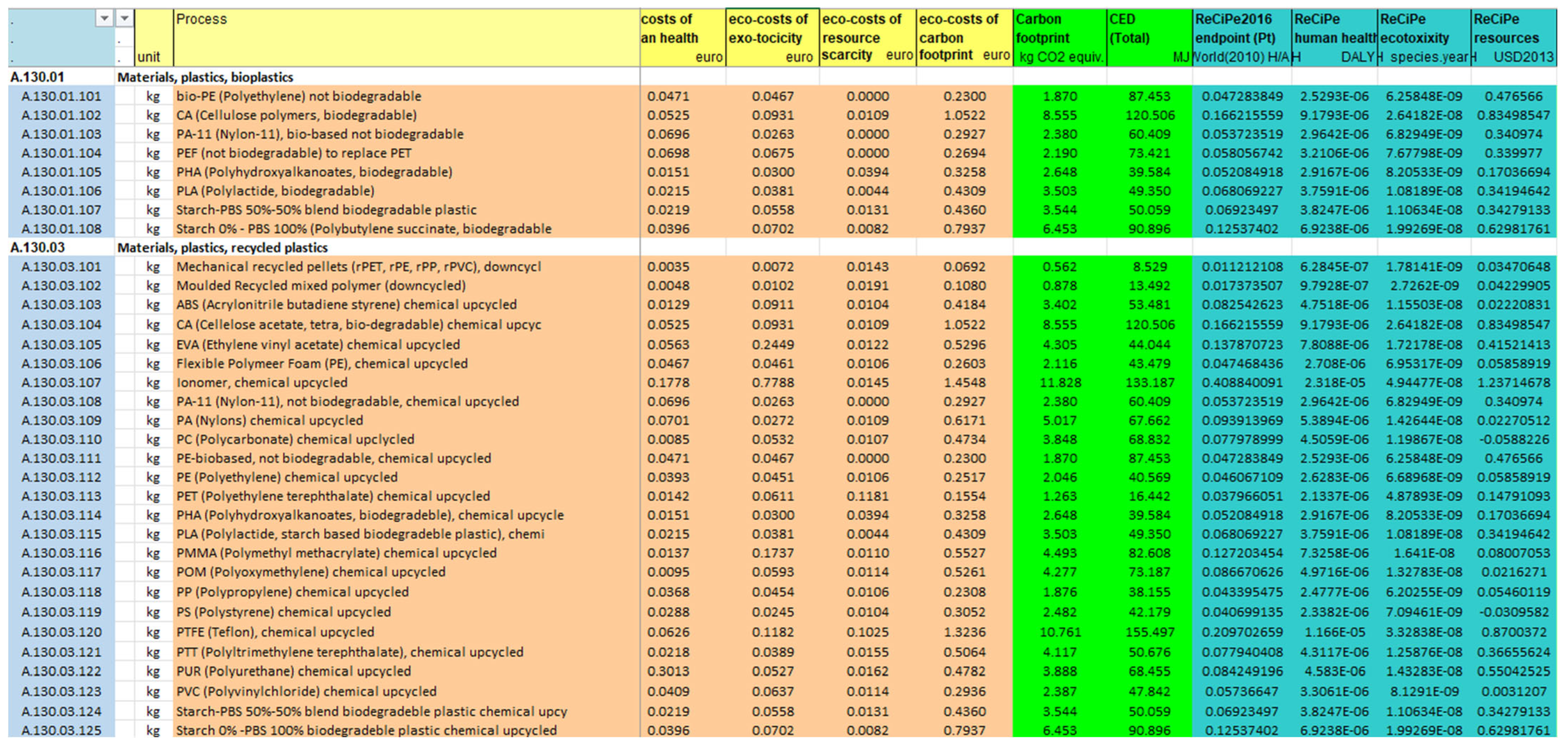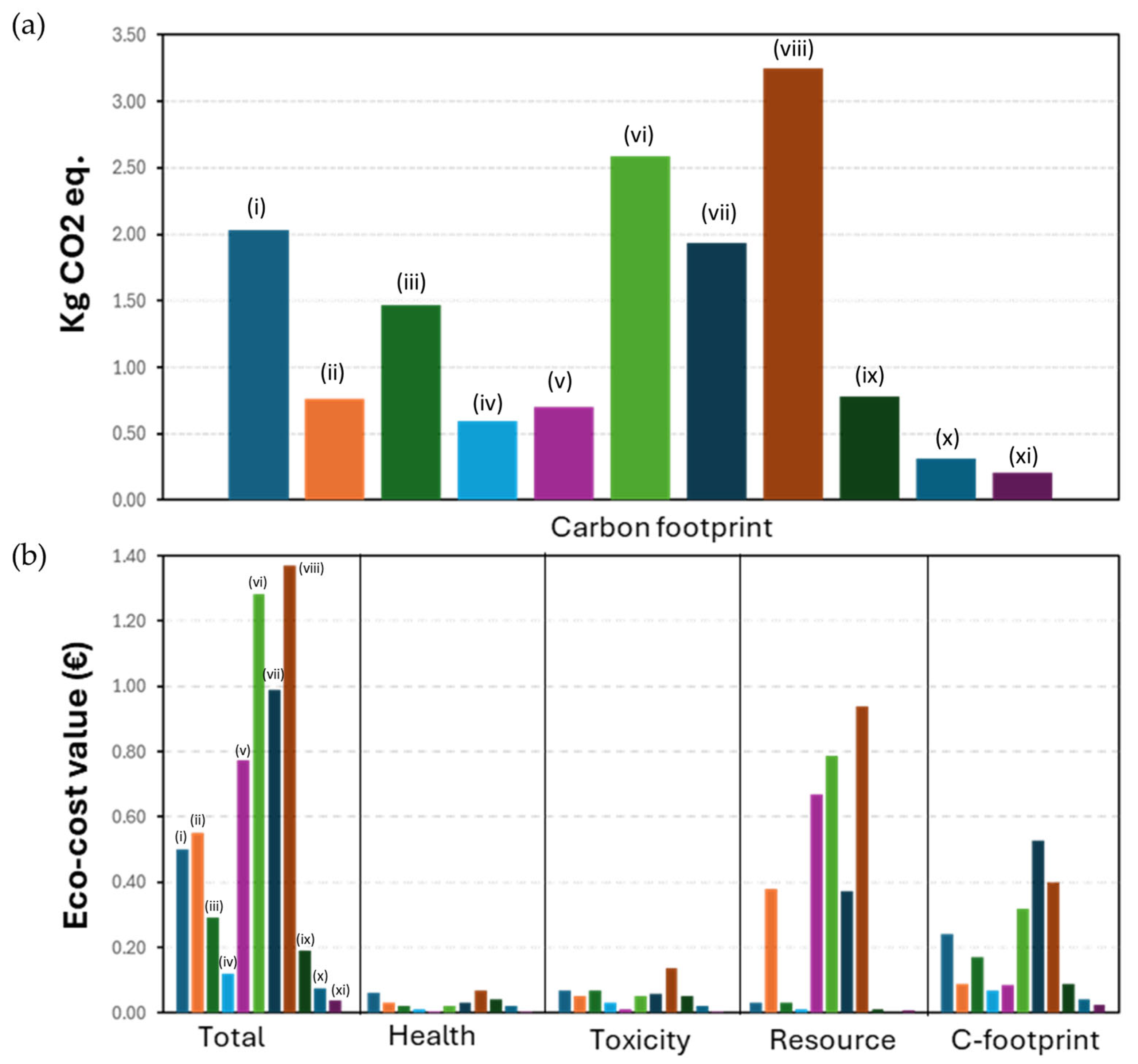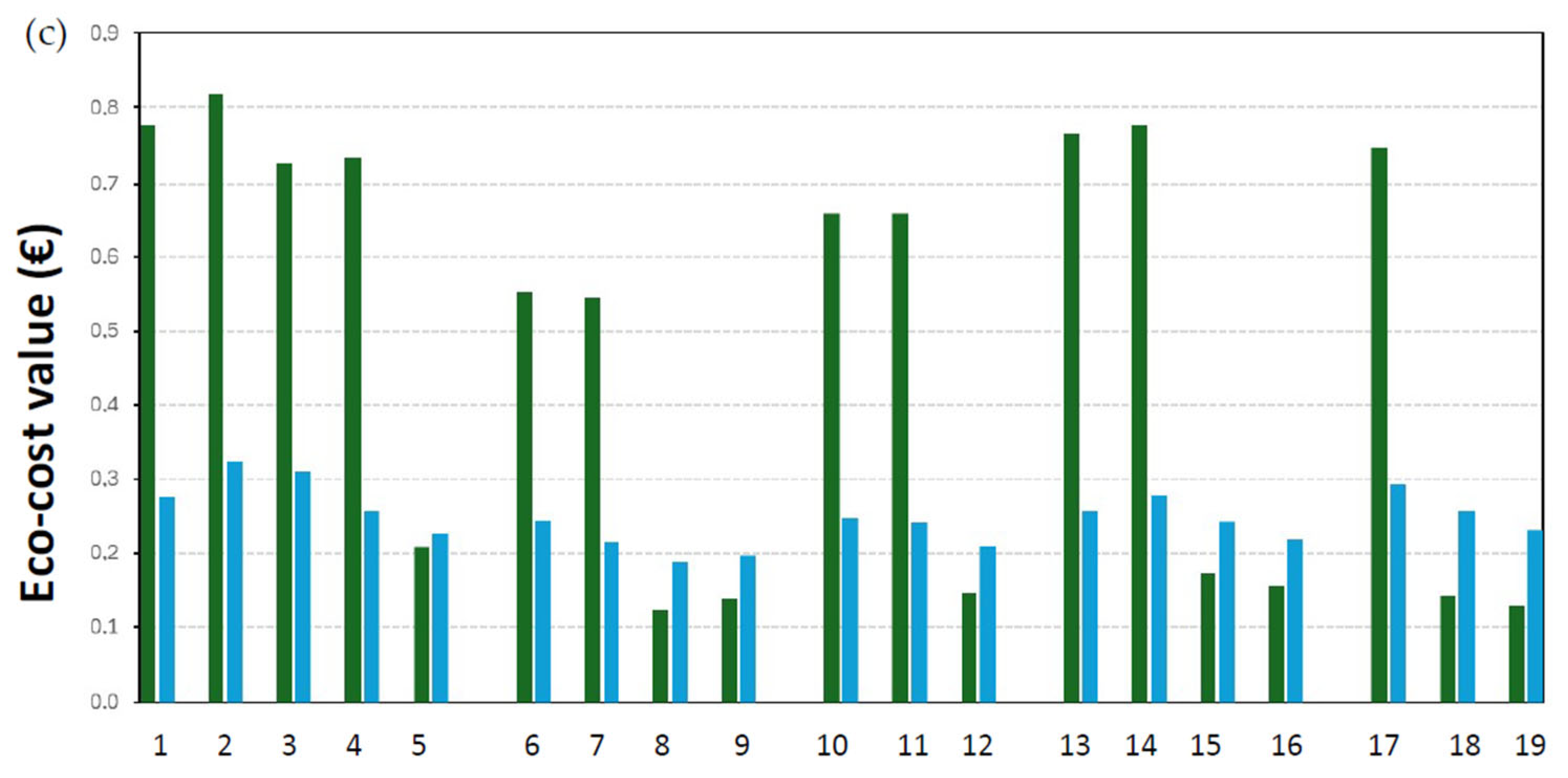Ab Initio Life-Cycle Analysis Assisting the Selection of Eco-Friendly Additives in Bio-Based Coatings †
Abstract
1. Introduction
2. Experimental Details
2.1. Methodology and Scope
2.2. Data Collection
3. Results and Discussion
3.1. Data Collection (Inventory) for Bio-Based Binders
3.2. Data Collection (Inventory) of Bio-Based Additives
3.3. Calculations for Bio-Based Coating Compositions
4. Conclusions
Author Contributions
Funding
Institutional Review Board Statement
Informed Consent Statement
Data Availability Statement
Conflicts of Interest
References
- Stichnothe, H.; Morgan, A.; Gujba, H.; Azapagic, A. Estimating the carbon footprint of paints: Some important considerations. Surf. Coat. Internat. 2011, 94, 108–114. [Google Scholar]
- Juhl, M.; Hauschild, M.Z.; Dam-Johansen, K. An eco-strategy for development of more sustainable coatings. Prog. Org. Coat. 2024, 197, 108781. [Google Scholar] [CrossRef]
- Hayeri, T. Bio-based oligomers: Progress, applications, and future perspectives. Sus. Chem. Eng. 2024, 5, 471–480. [Google Scholar]
- Marturano, V.; Marotta, A.; Salazar, S.A.; Ambrogi, V.; Cerruti, P. Recent advances in bio-based functional additives for polymers. Prog. Mater. Sci. 2023, 139, 101186. [Google Scholar] [CrossRef]
- Bishop, G.; Styles, D.; Lens, P.N.L. Environmental performance comparison of bioplastics and petrochemical plastics: A review of life cycle assessment (LCA) methodological decisions. Res. Cons. Recycl. 2021, 168, 105451. [Google Scholar] [CrossRef]
- Meisel, K.; Röver, L.; Majer, S.; Herklotz, B.; Thrän, D. A comparison of functional fillers: Greenhouse gas emissions and air pollutants from lignin-based filler, carbon black and silica. Sustainability 2022, 14, 5393. [Google Scholar] [CrossRef]
- Suarez, L.; Castellano, J.; Diaz, S.; Tcharkhtchi, A.; Ortega, Z. Are natural-based composites sustainable? Polymers 2021, 13, 2326. [Google Scholar] [CrossRef]
- Haylock, R.; Rosentrater, K.A. Cradle-to-grave life cycle assessment and techno-economic analysis of polylactic acid composites with traditional and biobased fillers. J. Polym. Environ. 2018, 26, 1484–1503. [Google Scholar] [CrossRef]
- Hahladakis, J.N.; Velis, C.A.; Weber, R.; Iacovidou, E.; Purnell, P. An overview of chemical additives present in plastics: Migration, release, fate and environmental impact during their use, disposal and recycling. J. Hazard. Mater. 2018, 344, 179–199. [Google Scholar] [CrossRef]
- Logan, H.; De Meester, S.; Damgaard, T.F.A. Additive inclusion in plastic life cycle assessments, part II: Review of additive inventory data trends and availability. J. Ind. Ecol. 2024, 28, 1554–1566. [Google Scholar] [CrossRef]
- Civancik-Uslu, D.; Ferrer, L.; Puig, R.; Fullana-i-Palmer, P. Are functional fillers improving environmental behaviour of plastics? A review on LCA studies. Sci. Total Envion. 2018, 626, 927–940. [Google Scholar] [CrossRef] [PubMed]
- Balcioglu, G.; Fitzgerald, A.M.; Rodes, F.A.M.; Allen, S.R. Data quality and uncertainty assessment of life cycle inventory data for composites. Comp. B Eng. 2025, 292, 112021. [Google Scholar] [CrossRef]
- Martinez-Rocamara, A.; Solis-Guzman, J.; Marrero, M. LCA databases focused on construction materials: A review. Renew. Sustain. Energy Rev. 2016, 58, 565–573. [Google Scholar] [CrossRef]
- Silva, E.; Fedel, M.; Deflorian, F.; Cotting, F.; Lins, V. Properties of post-consumer polyethylene terephthalate coating mechanically deposited on mild steels. Coatings 2019, 9, 28. [Google Scholar] [CrossRef]
- Richard, S.; Rajadurai, J.S.; Manikandan, V. Effects of particle loading and particle size on tribological properties of biochar particulate reinforced polymer composites. J. Tribol. 2017, 139, 012202. [Google Scholar] [CrossRef]
- Azadi, M.; Bahrololoom, M.E.; Heidari, F. Enhancing the mechanical properties of an epoxy coating with rice husk ash, a green product. J. Coat. Technol. Res. 2011, 8, 117–123. [Google Scholar] [CrossRef]
- Jimoh, O.A.; Ariffin, K.S.; Hussin, H.B.; Temitope, A.E. Synthesis of precipitated calcium carbonate: A review. Carbonates Evaporites 2018, 33, 331–346. [Google Scholar] [CrossRef]
- Hayeemasae, N.; Worlee, A.; Masa, A. Influence of calcium carbonate content on properties of natural rubber and acrylic blends for coating applications. J. Appl. Sci. Eng. 2025, 28, 411–419. [Google Scholar]
- Attharangsan, S.; Ismail, H.; Bakar, M.A.; Ismail, J. Carbon black (CB)/rice husk powder (RHP) hybrid filler-filled natural rubber composites: Effect of CB/RHP ratio on property of the composites. Polym. Plast. Technol. Eng. 2012, 51, 655–662. [Google Scholar] [CrossRef]
- Calovi, M.; Rossi, M. Impact of high concentrations of cellulose fibers on the morphology, durability and protective properties of wood paint. Coatings 2023, 13, 721. [Google Scholar] [CrossRef]
- Liang, G.; Qi, Y.; Gong, R.; Hu, Y.; Yao, F.; Liu, Y.; Liu, B.; Zhao, Y.; Dai, Y.; Dong, X.; et al. Nanocellulose-reinforced polyurethane as flexible coating for cork floor. Prog. Org. Coat. 2023, 178, 107480. [Google Scholar] [CrossRef]
- Nasri, N.S.; Ahmed, M.; Naemah, M.N.; Mohammed, J.; Hamza, U.D.; Zain, H.M. Hydrophobicity characterization of bio-wax derived from taro leaf for surface coating applications. Adv. Mater. Res. 2014, 1043, 184–188. [Google Scholar] [CrossRef]
- Martins, C.I.; Gil, V. Processing–structure–properties of cork polymer composites. Front. Mater. 2020, 7, 297. [Google Scholar] [CrossRef]
- Longo, A.; Nobre, C.; Sen, A.; Panizio, R.; Brito, P.; Goncalves, M. Torrefaction upgrading of heterogenous wastes containing cork and chlorinated polymers. Environments 2022, 9, 99. [Google Scholar] [CrossRef]
- Kargupta, W.; Seifert, R.; Martinez, M.; Olson, J.; Tanner, J.; Batchelor, W. Sustainable production process of mechanically prepared nanocellulose from hardwood and softwood: A comparative investigation of refining energy consumption at laboratory and pilot scale. Ind. Crops Prod. 2021, 171, 113868. [Google Scholar] [CrossRef]
- Jewiarz, M.; Wrobel, M.; Mudryk, K.; Szufa, S. Impact of the drying temperature and grinding technique on biomass grindability. Energies 2020, 13, 3392. [Google Scholar] [CrossRef]
- Hidalgo, P.; Salgado, L.; Ibacache, N.; Hunter, R. Influence of biochar and bio-oil loading on the properties of epoxy resin composites. Polymers 2023, 15, 1895. [Google Scholar] [CrossRef]
- Rudawska, A.; Frigione, M. Aging effects of aqueous environment on mechanical properties of calcium carbonate-modified epoxy resin. Polymers 2020, 12, 2541. [Google Scholar] [CrossRef]
- Baumgartner, G.L. Cork Composition Containing Epoxy. Resin. Patent US2904524A, 15 September 1959. [Google Scholar]
- Grötzinger, J.; Von der Brüggen, U.; Viertel, J.; Kasemi, E. Epoxy Resin Composition for Coating. Purposes. Patent US20200354604A1, 12 November 2020. [Google Scholar]
- Samyn, P.; Cosemans, P. Nanocellulose grades with different morphologies and surface modification as additives for waterborne epoxy coatings. Polymers 2024, 16, 1095. [Google Scholar] [CrossRef]







| Functionality | Fossil-Based Additive | Bio-Based Additive | Reference |
|---|---|---|---|
| Abrasion resistance | Silicate | Rice-husk biochar | [15,16] |
| Filler | Calcium carbonate (virgin) | Calcium carbonate (renewable) | [17,18] |
| Color | Carbon black | Rice-husk biochar | [19] |
| Mechanical reinforcement | Silicate | Cellulose fibers Nanocellulose (from cellulose fibers) Nanocellulose (from wood pulp) | [20,21] |
| Hydrophobicity | PE wax | Biowax Cork powder | [22,23] |
| Biomass | Conversion | Bio-Based Additive | Equivalent Energy |
|---|---|---|---|
| Rice husk | Pyrolysis | Rice-husk biochar | 20 MJ/kg [24] |
| Wood pulp | Grinding and shear homogenization | Nanocellulose | 108 MJ/kg [25] |
| Cellulose fibers | Grinding and shear homogenization | Nanocellulose | 63 MJ/kg [25] |
| Cork | Mechanical grinding and drying | Cork granulate | 0.1 MJ/kg [26] |
| Sample | Fossil Binder | Bio-Based Binder | Fossil Additive | Bio-Based Additive |
|---|---|---|---|---|
| Series 01 | ||||
| 1 | Fossil epoxy | |||
| 2 | Fossil epoxy | 10% carbon black | ||
| 3 | Fossil epoxy | 10% silicate | ||
| 4 | Fossil epoxy | 10% biochar | ||
| 5 | Bio-epoxy | 10% biochar | ||
| 6 | Fossil epoxy | 30% virgin CaCO3 | ||
| 7 | Fossil epoxy | 30% recovered CaCO3 | ||
| 8 | Bio-epoxy | 30% recovered CaCO3 | ||
| 9 | Bio-epoxy | 20% cork granulate | ||
| 10 | Fossil epoxy | 15% PE wax | ||
| 11 | Fossil epoxy | 15% biowax | ||
| 12 | Bio-epoxy | 15% biowax | ||
| Series 02 | ||||
| 13 | Fossil epoxy | 10% cellulose | ||
| 14 | Fossil epoxy | 0.75% nanocellulose from cellulose fibers | ||
| 15 | Bio-epoxy | 0.75% nanocellulose from cellulose fibers | ||
| 16 * | Bio-epoxy | 0.75% nanocellulose from cellulose fibers | ||
| 17 | Fossil epoxy | 0.75% nanocellulose from wood pulp | ||
| 18 | Bio-epoxy | 0.75% nanocellulose from wood pulp | ||
| 19 * | Bio-epoxy | 0.75% nanocellulose from wood pulp |
Disclaimer/Publisher’s Note: The statements, opinions and data contained in all publications are solely those of the individual author(s) and contributor(s) and not of MDPI and/or the editor(s). MDPI and/or the editor(s) disclaim responsibility for any injury to people or property resulting from any ideas, methods, instructions or products referred to in the content. |
© 2025 by the authors. Licensee MDPI, Basel, Switzerland. This article is an open access article distributed under the terms and conditions of the Creative Commons Attribution (CC BY) license (https://creativecommons.org/licenses/by/4.0/).
Share and Cite
Samyn, P.; Cosemans, P.; Vandenhaute, T. Ab Initio Life-Cycle Analysis Assisting the Selection of Eco-Friendly Additives in Bio-Based Coatings. Eng. Proc. 2025, 87, 76. https://doi.org/10.3390/engproc2025087076
Samyn P, Cosemans P, Vandenhaute T. Ab Initio Life-Cycle Analysis Assisting the Selection of Eco-Friendly Additives in Bio-Based Coatings. Engineering Proceedings. 2025; 87(1):76. https://doi.org/10.3390/engproc2025087076
Chicago/Turabian StyleSamyn, Pieter, Patrick Cosemans, and Thomas Vandenhaute. 2025. "Ab Initio Life-Cycle Analysis Assisting the Selection of Eco-Friendly Additives in Bio-Based Coatings" Engineering Proceedings 87, no. 1: 76. https://doi.org/10.3390/engproc2025087076
APA StyleSamyn, P., Cosemans, P., & Vandenhaute, T. (2025). Ab Initio Life-Cycle Analysis Assisting the Selection of Eco-Friendly Additives in Bio-Based Coatings. Engineering Proceedings, 87(1), 76. https://doi.org/10.3390/engproc2025087076






